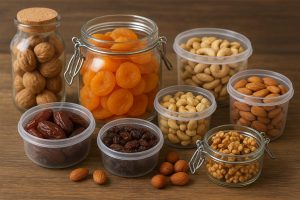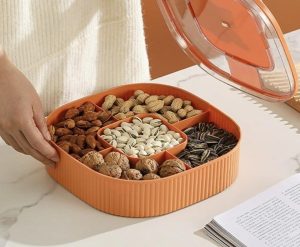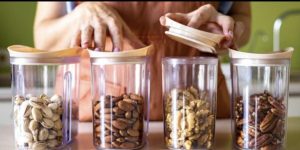
Looking for simple and easy tips to store Dry fruits and nuts? The ultimate guide to store dry fruits for maximum freshness is to keep them in airtight containers, away from heat, moisture, and direct sunlight. Dry fruits are packed with nutrients, but storing them the wrong way can cause them to lose flavor, texture, and health benefits. Proper storage ensures they stay crunchy, delicious, and nutrient-rich for months.
Introduction
Dry fruits like almonds, walnuts, raisins, figs, pistachios, and cashews are often called nature’s healthy snacks. They’re rich in vitamins, minerals, fiber, and antioxidants. But because they contain natural oils and moisture, they are sensitive to air, light, and temperature changes. That’s why knowing how to store dry fruits correctly is so important.
Best Way to Store Nuts and Dry Fruits for Longer Shelf Life
If you want to extend the shelf life of your snacks, the best way to store nuts and dry fruits is by using airtight glass jars or vacuum-sealed containers. Nuts contain natural oils that can go rancid if left in warm or humid conditions, while dry fruits can become sticky or moldy. To prevent this, always keep them in a cool, dark place, preferably in the refrigerator or freezer if you buy in bulk. Another tip is to divide large quantities into smaller containers—this reduces exposure to air every time you open a jar. By following these steps, you’ll not only maintain freshness but also preserve nutrients, taste, and crunch for months.
Proper Dry Fruit Storage Tips for Everyday Use
Many people buy dry fruits for daily snacking, but few know the right techniques for keeping them fresh. The most effective dry fruit storage tips include keeping them away from strong-smelling foods, as nuts and dried fruits can easily absorb odors. Always use clean, dry containers and avoid plastic bags for long-term storage since they allow moisture and pests to enter. If you use dry fruits regularly, store a small portion in the pantry for convenience while keeping the rest in the refrigerator or freezer. This way, you always have a ready supply of fresh, crunchy snacks without worrying about spoilage.
Without Proper Storage, Dry Fruits May:
- Turn rancid due to oxidation.
- Harden or develop mold.
- Spoil and attract pests due to moisture.
Whether you buy dry fruits in bulk, receive them as gifts, or stock them for daily use, understanding proper storage helps maintain taste, nutrition, and shelf life.
In this guide, we’ll cover:
- The science behind dry fruit storage
- General storage rules
- Best containers and packaging solutions
- Storage methods for different types of dry fruits
- Seasonal and bulk storage tips
- Signs your dry fruits have gone bad
By the end, you’ll know exactly how to store dry fruits fresh, safe, and flavorful.
The Science Behind Storing Dry Fruits
Dry fruits contain natural oils, sugars, and sometimes residual moisture. When exposed to air, heat, or humidity, they deteriorate quickly.
- Oxidation – Nuts like walnuts and almonds are high in unsaturated fats. These break down when exposed to oxygen, causing a bitter or rancid taste.
- Moisture damage – Raisins, figs, and dates absorb water easily, making them sticky or moldy.
- Heat exposure – Warm temperatures speed up oil breakdown and nutrient loss.
- Light sensitivity – Vitamin E and antioxidants degrade when exposed to light.
- Pests and insects – Improperly sealed dry fruits attract weevils, ants
General Rules for Storing Dry Fruits
To keep dry fruits fresh:
- Use airtight containers – Glass jars, stainless steel tins, or BPA-free plastic prevent air exposure.
- Keep in a cool, dry place – Avoid stoves, windows, or humid kitchens.
- Avoid direct sunlight – Store in opaque jars or cupboards.
- Refrigerate or freeze for long-term storage – Especially for walnuts, pecans, and pine nuts.
- Use silica gel packs – Food-safe desiccants absorb extra moisture.
- Don’t mix different dry fruits – Each has unique oil and moisture levels.
- Follow FIFO (first in, first out) – Use older stock before new purchases.
These are the foundation of how to store dry fruits properly.
Best Containers for Storing Dry Fruits

Choosing the right container makes a huge difference. For anyone searching for how to store dry fruits correctly, here are the best options:
- Glass Jars – Non-reactive, airtight, and preserve flavor well.
- Stainless Steel Containers – Durable, block light, and last for years.
- BPA-Free Plastic Containers – Lightweight, good for short-term storage.
- Vacuum-Sealed Bags – Remove oxygen completely, extend shelf life by months.
- Zip-Lock Bags – Convenient for travel or small servings.
How to Store Specific Dry Fruits
Almonds
- Shelf Life: 6–12 months pantry, 1–2 years fridge.
- Best Storage: Airtight glass jars in a cool cupboard. Refrigerate bulk.
Walnuts
- Shelf Life: 3–4 months room temp, 1 year fridge.
- Best Storage: Always refrigerate or freeze.
Cashews
- Shelf Life: 6 months pantry, 1 year fridge.
- Best Storage: Airtight tins or jars.
Pistachios
- Shelf Life: 3–6 months pantry, 1 year fridge.
- Best Storage: Airtight jars, unshelled last longer.
Raisins
- Shelf Life: 6 months pantry, 1 year fridge.
- Best Storage: Airtight jars away from heat.
Figs
- Shelf Life: 3–6 months room temp, 1 year fridge.
- Best Storage: Airtight jars or sealed pouches.
Dates
- Shelf Life: 6 months pantry, 1 year fridge, 2 years freezer.
- Best Storage: Airtight containers in fridge.
Mixed Dry Fruits
- Store separately to avoid flavor mixing and uneven spoilage.

Refrigeration vs Freezing: Which is Better?
- Refrigeration – Ideal for daily use, keeps fresh 6–12 months.
- Freezing – Best for bulk, extends shelf life up to 2 years.
- Thawing – Always thaw in the fridge, not at room temperature.
Storing Dry Fruits During Different Seasons
- Summer – Refrigerate to prevent oils from going rancid.
- Rainy Season – Use silica gel packs to combat humidity.
- Winter – Room temp is fine, but keep away from heaters.
Seasonal awareness is key to mastering how to store dry fruits all year round.
Bulk Storage and Gifting Tips
Festivals and weddings often involve bulk buying. Here’s how to store dry fruits when dealing with large quantities:
- Pack in airtight tins, not plastic bags.
- Add food-safe desiccant packs.
- Divide into smaller containers to reduce exposure.
- For gifting, use vacuum-sealed pouches for freshness.
Signs Your Dry Fruits Have Gone Bad
- Rancid smell – Like paint or chemicals.
- Bitter taste – Oils have oxidized.
- Sticky or moldy – Moisture damage.
- Discoloration – Oxidation or fungal growth.
- Insects or larvae – Poor sealing.
Rule of thumb: When in doubt, throw it out.
Quick Checklist for Freshness
- Store in airtight containers.
- Keep away from heat, moisture, and light.
- Refrigerate for long-term use.
- Use silica gel packs if needed.
- Don’t mix types of dry fruits.
- Rotate stock (FIFO rule).
FAQs: Storing Dry Fruits
Q1. How long can dry fruits last without refrigeration?
Most last 3–6 months in airtight containers at room temperature. For longer storage, refrigeration is the safest option when considering how to store dry fruits.
Q2. Can I freeze all types of dry fruits?
Yes, almost all nuts and dried fruits can be frozen safely in freezer-safe bags or containers. Freezing is one of the best answers for how to store dry fruits long-term.
Q3. Should I wash dry fruits before storing them?
No. Washing introduces moisture, which can cause mold. Wash only before eating.
Q4. How do I keep raisins and figs from hardening?
Keep them in airtight jars in a cool place. If they harden, soak in warm water before use.
Q5. Why do nuts turn bitter?
Because natural oils oxidize when exposed to air, heat, or light. That’s why how to store dry fruits properly is crucial.
Q6. Is vacuum sealing worth it?
Yes, especially for bulk storage. Vacuum sealing removes oxygen, extending freshness up to 2 years.
Conclusion
Dry fruits are nutritional treasures, but also delicate. By following best practices for how to store dry fruits, you can preserve their crunch, taste, and nutrients for months—or even years. From airtight containers to refrigeration, freezing, and vacuum sealing, every detail matters.
The next time you buy in bulk or receive a festive gift, remember: freshness depends not just on what you buy but on how to store dry fruits after purchase. By mastering these simple yet effective methods, you’ll always enjoy your favorite dry fruits.
For more premium dry fruit collections, visit our Monuts Store.
Learn more about the health benefits of nuts and dry fruits from Heerson.

